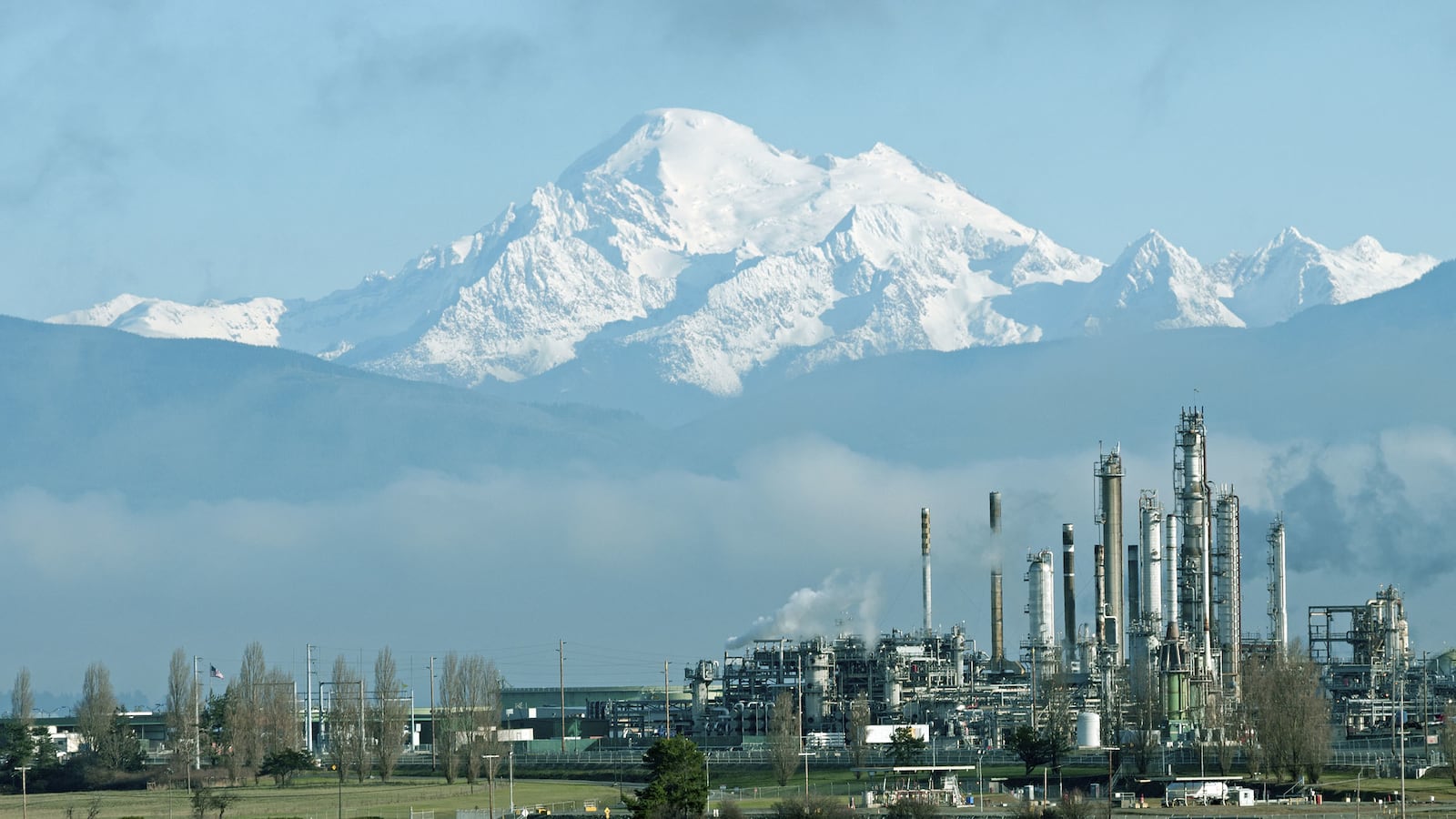Seventy miles north of Seattle, the Tesoro Anacortes rail facility—which daily offloads some 50,000 barrels of Bakken crude from tanker cars—was releasing a highly flammable oil byproduct into a stormwater system that lacked “required controls” for at least a year before state regulators were made aware of the potential hazard.
A faulty pipe connection was the source of the problem, according to a Northwest Clean Air Agency enforcement report obtained via an open-records request. As a result of the flaw, hydrocarbon vapors were being produced in the rail facility’s stormwater system that could have ignited under the right conditions, experts say.
Tesoro officials insist there was no risk of fire.
Yet state regulators never inspected the rail facility to assess the fire risk because it appears those charged with ensuring public safety were caught up in a maze of Catch-22 rules that work against timely assessment of potential worker-safety and fire hazards.
NWCAA inspectors did not visit the rail facility until five months after Tesoro had disconnected the problematic pipe. Still, the agency’s enforcement report indicates that vapors containing “volatile organic compounds” were still being released from numerous points in the company’s stormwater system, parts of which are located a stone’s throw from the crude-oil railcar staging area.
“At the time of inspection, there was one unit train [which can haul some 65,000 barrels of crude] unloading while another unit train had recently arrived full and was idling on the holding track,” the NWCAA enforcement report states.
The NWCAA is an air-quality control agency established under the Washington State Clean Air Act.
“Any vapor is a concern. It’s the vapor that burns, not the liquid,” says Kelly Blaine, the fire marshal for Skagit County, where the rail facility is based. “But it has to be the perfect conditions to ignite within the right thresholds, and you need an ignition source. So it can ignite, but it’s rare.”
Blaine stresses that he was not called to inspect the rail site. “The people that regulate it are not us [the fire marshal’s office],” he says. “That would be the state’s job.”
Tesoro Corp.’s corporate headquarters in San Antonio, Texas, says “there was no fire risk” from the Bakken crude liquid and vapor in the stormwater system.
“The [notice of violation from the NWCAA] involved a very small amount of oily water released due to an open valve on a small-diameter line,” Tesoro spokesperson Megan Write says. “Corrective action was taken to address this issue swiftly.”
Still, the notice of violation [NOV] was deemed serious enough for Tesoro to report it to its shareholders in a recent Securities and Exchange Commission filing.
“On March 12, 2014 the Northwest Clean Air Agency issued a NOV… alleging a violation of air-quality regulations at [the] Anacortes Crude Rail Offloading facility,” an August filing by Tesoro with the SEC states. “The allegation concerns hydrocarbon releases from the wastewater system at the unloading facility.”
Tesoro ships the crude oil used to feed its refinery in Anacortes, which is adjacent to the rail facility, via mile-long trains that are loaded in the Bakken Shale Play that spreads across parts of North Dakota, Montana, and Canada. En route to Anacortes, those trains travel through downtown Seattle—the site of a derailment this summer that damaged several tanker cars heading to the refinery.
A material-safety data report produced by Tesoro describes the Bakken crude as being highly flammable with a variable flash point below 100 degrees—meaning it’s capable of igniting on a hot summer’s day at pavement level in Seattle. Tesoro’s report on its crude product also states that vapors produced by the oil “are heavier than air and may travel long distances to a point of ignition and flash back.”
“Do not allow liquid runoff to enter sewers or public waters,” the report states. “Gas may form explosive mixture with air."
Toby Mahar, the NWCAA engineer who conducted the inspection of the Tesoro rail facility, said she did not assess the chemical components or explosive attributes of the crude-oil vapors being emitted from the rail-facility’s stormwater system, nor did she measure vapor levels inside the company’s system.
Though the vapors emitting were in relatively high concentrations at one point in the system, she says the volume of gas being released was low.
“I’m using a pretty sensitive instrument” to measure the vapor release, Mahar added.
When asked if she would feel comfortable holding a match over the locations emitting the vapors, Mahar replied:
“I would never feel comfortable dropping a match in any refinery, anywhere. There’s safety procedures that require non-sparking equipment. I turn off my cellphone and I leave my keys in my car.”
Volatile vapors form, Mahar explained, as the crude oil is transferred from the railcars into the rail facility’s pipeline system. Those vapors condense into a liquid later in the process and that “condensate” is collected in a storage area, called a sump. The condensate is then supposed to be routed into the pipeline system that delivers the crude to the nearby refinery. Instead, due to a plant construction flaw, it was being sent into a stormwater system not permitted to handle that material, resulting in the vapor venting from that system.
Mahar’s inspection of the Tesoro facility occurred after the company disconnected the errant line, which—prior to her site visit in February 2014—had been conveying crude-oil condensate into the sewer system for some 12 months, from Sept. 4, 2012, when the facility opened, to Sept. 5, 2013. A new line was then installed and routed to the facility’s oil-pipeline system. As a result, the vapor measurements Mahar obtained are likely the best-case scenario.
Mahar stressed that her enforcement report dealt only with regulations related to air-quality standards, adding that she was not qualified to assess worker-safety or fire-hazard conditions at the rail facility.
“The reality is… we [NWCAA] don’t implement safety procedures,” Mahar said. “The reason [Tesoro] got a violation is because they had an equipment violation. … I don’t know OSHA [U.S. Occupational Safety and Health Administration] rules, nor does it matter to me.”
As it turns out, the OSHA-certified state agency responsible for inspecting refinery sites for potential worker-safety and fire hazards, Washington’s Division of Occupational Safety and Health, has no record of any inspection being conducted at the Tesoro rail facility related to the NWCAA enforcement action, as a public-records request reveals. NWCAA Communication Director Katie Skipper confirmed that her agency “would only be required to report the violation to the U.S. EPA [the Environmental Protection Agency] if it was considered a high-priority violation, as EPA defines it.”
EPA spokesman Mark MacIntyre said that NWCAA was, in fact, “not required by law” to notify his agency of the Tesoro rail-facility violation.
“With that said, had we been notified about the air violations, we would probably not have conducted any air inspections or other follow-up regarding potential fire risk,” he added. “Our focus would have been on air releases under the Clean Air Act requirements for protection of air quality, not for prevention of fire or explosion.”
The end result is that in the case of the Tesoro rail facility, the public simply doesn’t know the extent of the danger because regulators never conducted fire-hazard tests, and consequently we have to rely on the assurances of Tesoro.
It’s worth noting that the company’s refinery in Anacortes was the scene of a major explosion in April 2010 that killed seven workers. That incident was due to an “equipment” problem (a steel tube ruptured)—resulting in explosive vapors being released and ignited.
In the wake of that incident, the U.S. Chemical Safety and Hazardous Investigation Board issued a report critical of the state of Washington’s DOSH—part of the Department of Labor & Industries—indicating that the agency has “significant weaknesses in… staffing.”
“Washington L&I has only four inspectors, and only one with a technical background, for more than 270 [regulated] facilities, including five petroleum refineries,” the May 2014 CSB report states.
CSB also took a hard shot at Tesoro.
“The CSB found several indications of process-safety culture deficiencies at Tesoro Anacortes Refinery,” the board’s report states. “Refinery management had normalized the occurrences of hazardous conditions.”
Mahar, who was recently promoted to compliance manager for NWCAA, said that Tesoro has its own set of safety requirements for the rail facility, “and the guys there want to be safe.”
Yet she also conceded that there is some crude residue still inside the Tesoro rail-facility stormwater system. She compared it to a car leaking oil onto cement: “It’s just hard to clean that up.”
As far as the enforcement action itself, the notice of violation issued against the Tesoro affiliates that operate the railcar facility is still pending settlement.
“We’re still talking about long-term resolution… and how going forward what compliance is going to look like,” Mahar said. “There’s lawyers involved, so it takes a little time.”Bill Conroy is a Seattle-based freelance writer.






